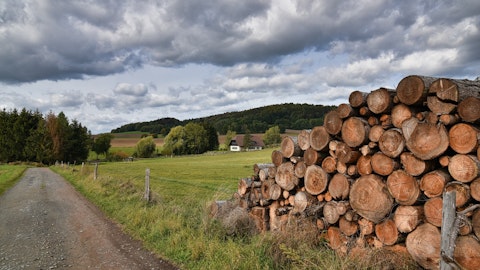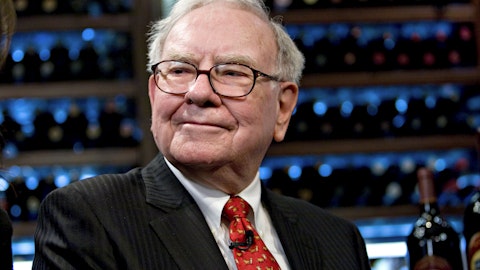And as we look forward into next year, we see that opportunity for growth, as I’ve already mentioned. And we are building off from a Siding standpoint, we’re building off a very small base, and so with the big national builders. So the ability for us to grow that what for us would be substantially is we’re pretty encouraged about, but it will take time. But the good thing about these deals is they are multiyear or at least a single year, at least, and so there is some surety of supply once you’re able to retain it or get it.
Michael Roxland: And then just one quick follow-up on your competitors, I believe one is out with a Siding price increase in early January. Is that something that maybe you could use your advantage and maybe in terms of trying to gain share, use that against them as they’ve — my understanding, have been pretty aggressive with their pricing with builders over the last 12 to 15 months or so?
Brad Southern: Well, there’s — I answered that a little bit more generally than against just one competitor. I mean, obviously, when it comes to these big programs, price or cost of the whole package is critical to the success there. And so yes, I mean, if a competitor has a higher price than us and that box gets ticked in our favor to work these deals but typically, that kind of obviously gets worked out in the back end anyway. And so really, where we’re trying to compete is off our value proposition, which is the quality of the product, the aesthetics of the product and the ease of installation. And so that’s how we lead. And then, obviously, though, at the end of the day, we’ve got to be competitive on price as well. And as I’ve mentioned, probably 100 times already four or five times on this call, we finally, have a product we’re able to be competitive on pricing as well as bringing all the other advantages of SmartSide to the builder conversation.
Operator: [Operator Instructions] And that will come from the line of Susan Maklari with Goldman Sachs.
Susan Maklari: My first question is last quarter you had mentioned that you saw a fairly substantial decline in shed demand during that, and that was part of what was going through that Siding segment. Is there anything that’s changed or that is impacting the business as you think about the fourth quarter guide there?
Brad Southern: No, the shed business has rebounded a good bit from what we reported for what would have been Q2 results. I will call that back to more of a normal cadence there. I do think the — or just overall demand and that channel all has been suppressed this year a little bit given how active it was last year. But we feel good and I’ll reiterate all of those customers are also back on our order file, and so we are seeing pulls in shed. And then typically — so there is a little bit more of a call this time from now on as folks build some inventory and prep of the builds they do to have product to sell in the spring. And so typically late Q4 to early Q1 are pretty strong product pulls in that segment. We’re expecting similar — expecting to see that increase in demand as we look forward.
And so I would call it back to normal though I will say compared to all the other channels, normal is probably still a little less than what the kind of demand we were seeing in 2021 and 2022.
Alan Haughie: I have to add something for the general audience as well. The Q4 revenue guide for Siding does include the fact that we are limiting prebuy in advance of January price increase, partly so that we don’t have a repeat of last year where we limited our ability to reap the market. So the Q4 guide does include a limited on prebuy.
Susan Maklari: And then maybe turning to OSB for a minute. When you think about that segment, and sort of the more recent trends there, that you think they’re a bit in contrast to what we are seeing from especially the large big public builders and their tone as they think about 2024? Can you just comment a bit about the channel inventories in OSB, including perhaps some of your structural solution products in there? And how you’re thinking about the potential for those volumes to move over the fourth quarter or maybe even into the early parts of 2024?
Brad Southern: Well, look, inventory situation in the channel for OSB remains, I would say, normal to slightly lean currently as of today, that can change pretty quickly in the OSB world. So I know you understand. But I would — unlike Siding, there’s really never was any meaningful OSB inventory build. I mean it can happen for two or three weeks at a time, but typically, our order file is staying pretty normal right now. So we’re not having — we’re not extending it, we’re not shortening it. And I feel good about where inventories are. I mean I do think there’s going to be some seasonal component to demand with the builder beginning Thanksgiving, the week of Thanksgiving through probably first couple of weeks of January, that’s normal of what we’ve seen historically.
The pre-COVID, before COVID screwed all seasonality up for us. So I would not be surprised to see the OSB demand decline, again, around the Thanksgiving time frame. Typically, our channel partners are going to one across the year with its lean inventories as they can kind of live with. So we also get a little bit of that negatively impacting demand. And then we typically get a pop once folks are back from the holidays and then they start looking forward to the spring building season. So I’m expecting for both Siding and OSB for this normal seasonality to return this year. We have not had that over the last three winters, so we’re planning accordingly. We obviously have the ability to respond in both businesses either up or down as real demand becomes apparent.
But I can see and personally see building slowing from middle of November to middle of January.
Operator: [Operator Instructions] And that will come from the line of Ketan Mamtora with BMO.
Ketan Mamtora: Alan, just one quick clarification to what you just said. So should I read this as you guys are already out in the market with the January price increase on Siding?
Brad Southern: We have communicated to the channel, a price increase is coming. We’ll be communicating — those are highly tailored by region, by channel. And so that specific communication will be going out over the next couple of weeks. It is a January 1 price increase. And as Alan mentioned, we’re doing it a little different this year in the way we’re implementing that. Historically, we have allowed our channel partners to buy 110% of their kind of normal purchases like prior six months or something like that. We’ll pick a time frame and so you can buy 110%. We’re doing this year — going to buy 100% of your prior purchase history as a way to mitigate the probability of us building prebuys impacting Q4 positively and Q1 negatively.




